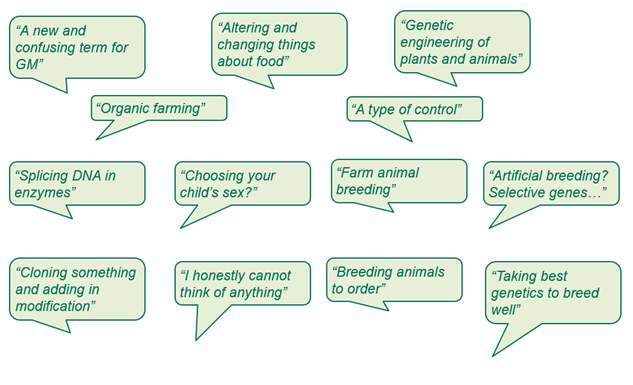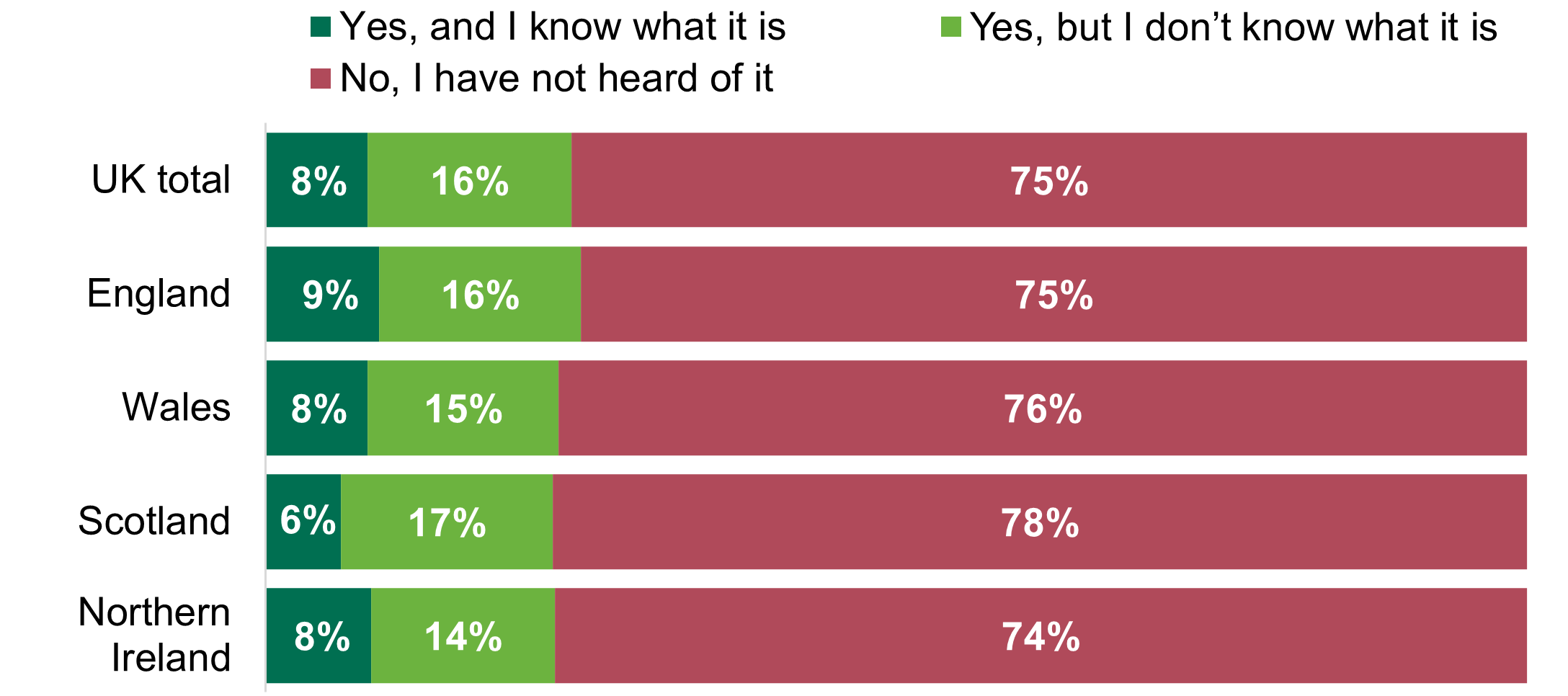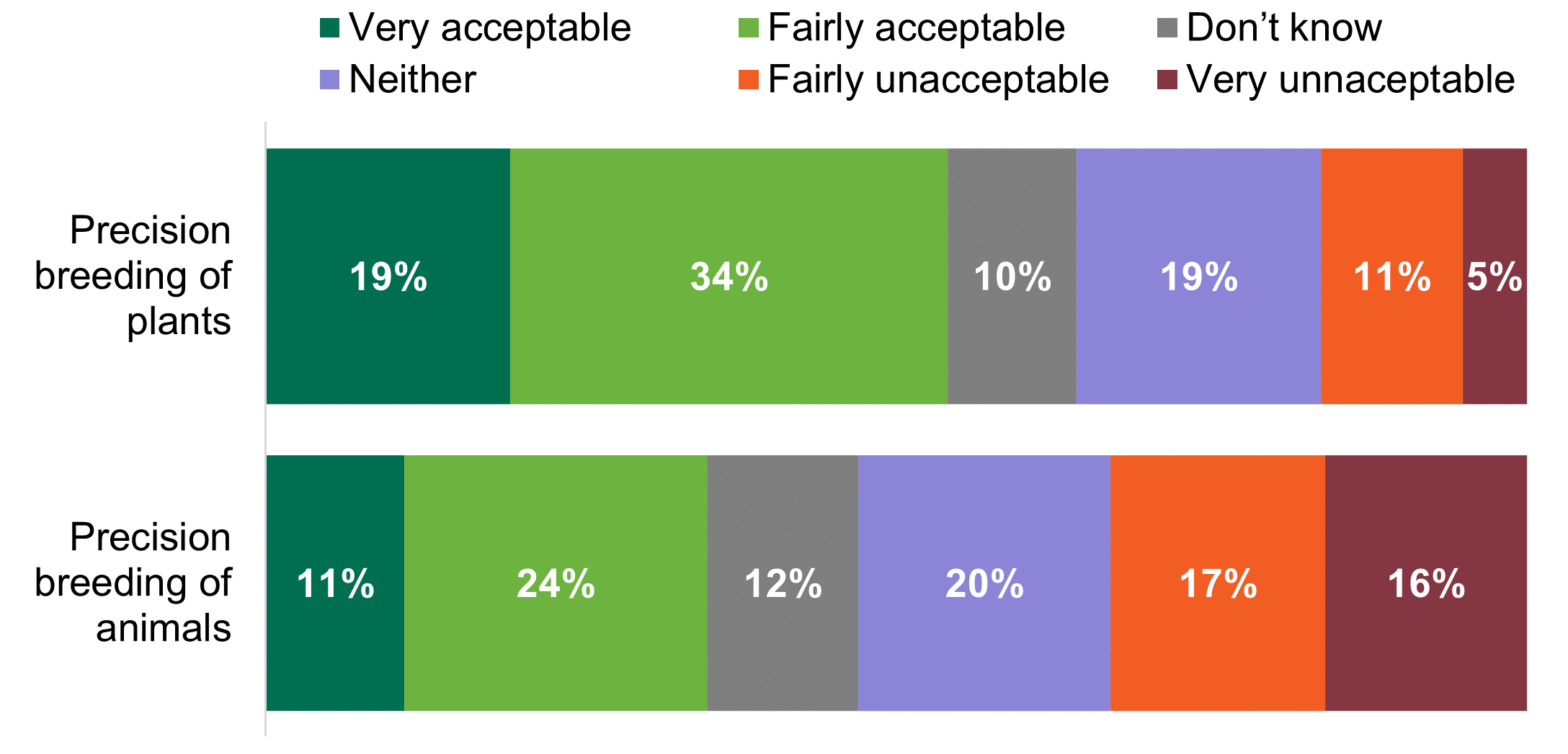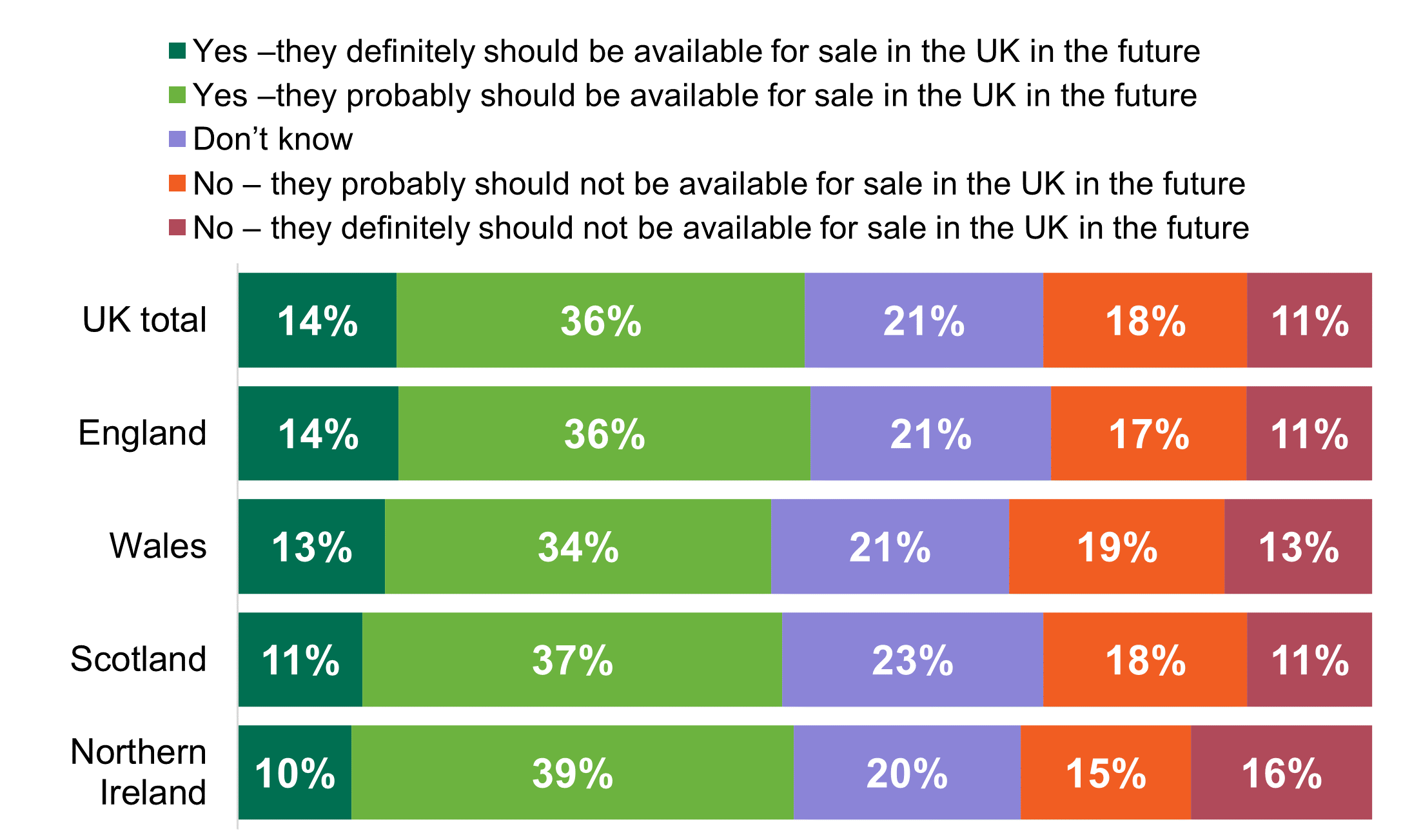Consumer perceptions of precision breeding: Awareness and understanding of precision breeding
This section looks at public awareness and understanding of precision breeding.
Baseline public awareness
Workshop 1 began with an introduction to precision breeding, outlining the key scientific concepts, and how the method compares to conventional methods, and genetic modification.
Figure 4: Uninformed views of what 'precision breeding' means, from workshop chat function

Before this information was shared with participants, they were asked if they had heard of precision breeding or knew what it is. Very few participants had ever heard of precision breeding, and generally they did not know what the term referred to. They did however make some guesses before information was presented to them, often suggesting: a new term for genetic modification, artificial selection, or breeding animals (rather than plants).
This aligns with the quantitative findings, where respondents’ claimed awareness of precision breeding was low. Three quarters (75%) have not heard of precision breeding, whilst just one in twelve (8%) have and know what it is, and 16% have heard of it but are unfamiliar.
Awareness is slightly higher among men (12% saying they know what it is) and those living with children (15%). People in England (9%) are more likely to say they know what is compared to people in Scotland (6%).
Figure 5: Have you heard of precision breeding before?

Base: All UK respondents (4,177), and in England (1,900), Wales (1,016), Scotland (1,005) and Northern Ireland (256).
During workshops, the introduction to precision breeding shared with participants explained that:
Precision breeding is a term used to describe a range of modern scientific methods for editing an organism’s DNA.
Precision breeding makes changes to a plant or animal that could have happened naturally through traditional breeding methods but can now be made to happen more quickly and more predictably.
This might be done to make things more resistant to disease, need less water to grow, or to increase the nutritional content.
Participants were also shown definitions of other methods including artificial selection, induced mutation, and genetic modification. They were shown two informational videos about precision breeding, and the CRISPR tool. The full Workshop 1 materials can be found in Appendix 3.
After they had been presented with this information, participants discussed their familiarity with this information and shared their assumptions.
It was clear that participants had very low awareness about precision breeding. However, it is important to note that they also had low awareness and understanding of food production methods generally, including conventional breeding methods. This made it challenging for some participants to grasp the differences between methods, as they learned about them all at once.
Participants were also surprised and sometimes felt uncomfortable about conventional breeding methods, having previously assumed that there was less human intervention in breeding for food production. Induced mutation in particular was worrying for participants, due to the use of chemicals or radiation. They noted that they were unaware of these methods previously and had questions about them.
“The radiation shocked us all, that they are doing that with food. It's a worry with our health.” (Workshop 1, England)
“I associate radiation with something harmful, and hazardous. So, if they're doing that to foods, what is that transferring to people who eat it?” (Workshop 1, Northern Ireland)
This context is key when analysing participant reactions to precision breeding, as awareness of other breeding methods often shaped participants reactions to information about precision breeding.
- Those who were more familiar with conventional breeding methods and the concept of mutations were often more open to the idea of precision breeding, seeing this as similar to selective breeding.
- Those who were unfamiliar with conventional methods were often surprised by the level of human intervention overall, and sometimes responded by feeling that humans should intervene less and focus on ‘natural’ methods.
- Those who were aware of genetic modification quickly recalled controversy and public distrust in these approaches. These participants often voiced initial wariness of precision breeding, viewing it as closer to genetic modification than conventional methods, or even viewing it as a re-brand of genetic modification.
Although awareness was very low in workshops, there were participants who had heard of precision breeding, and a few who knew about CRISPR specifically. These participants said they had heard about it from EU-Exit related news about trade and imports, or from New Scientist articles about scientific developments.
Understanding of and reactions to precision breeding information
Participants’ comprehension and reactions to the definitions were varied. This chapter discusses how participants interpreted this information, what the common areas of confusion were, and gives insight into how precision breeding can best be explained.
There were several key initial reactions to precision breeding, which underpinned participants’ overall attitudes:
- There were participants who viewed precision breeding as a natural progression from conventional breeding, and the logical next step in farming technology. These participants often described precision breeding as a faster more precise method for selective breeding, and therefore not too different from conventional methods. This view led participants to consider ways in which the technology could create solutions to current global challenges such as food scarcity and climate change.
- There were also many participants who viewed precision breeding as unnatural interference, and just a re-brand of genetic modification. These participants often described precision breeding as an unpredictable technology, with no way to truly know the health or environmental impacts. This view led participants to raise ethical questions about the morality and risks of ‘messing with nature’ or ‘playing God’ by altering the DNA of other organisms.
Both the workshop and survey findings demonstrated that precision breeding is less acceptable for consumers in animals than in crops. A majority of survey respondents (54%) think it would be acceptable to use the precision breeding of plants in food production, whilst 16% say it would be unacceptable. However, respondents are more divided over whether precision breeding of animals is acceptable (35% acceptable, 33% unacceptable).
Figure 6: How acceptable or unacceptable, do you think it is to use the following in food production?

Base: All UK respondents (4,177), and in England (1,900), Wales (1,016), Scotland (1,005) and Northern Ireland (256).
Overall, half (50%) think that precision bred food products are safe to eat, and 22% think they are unsafe. Again, attitudes are soft with just 13% thinking these products are “very safe”. People in Northern Ireland are less likely to think they are safe (42% compared to 28% who say unsafe). Those most likely to think they are safe include Londoners (63%), men (58%), 16–34-year-olds (56%), households with children (56%), higher socio-economic groups AB (55%), graduates (54%), and people who like unfamiliar foods (60%).
Half of survey respondents (50%) say that precision bred food products should be available for sale in the UK in the future, compared to fewer than three in ten (29%) who said they should not be. However, this support is not particularly strong, with one in seven (14%) saying they definitely should be available, compared to just over a third thinking they probably should be available (36%). People in Wales are slightly less likely to think these products should be available for sale (47%).
Figure 7: Do you think that precision bred food products should, or should not, be available for sale in the UK in the future?

Base: All UK respondents (4,177), and in England (1,900), Wales (1,016), Scotland (1,005) and Northern Ireland (256).
Workshop participants also had initial reactions to the terminology used, either the term ‘precision breeding’, or in the words used to describe the process. The word ‘breeding’ itself was very closely associated with livestock rather than crops, which was off-putting to some participants because precision breeding in animals was often not seen as acceptable. Participants suggested that ‘grown’ or ‘cultivated’ or even ‘engineered’ are words that are more closely associated with plants.
"It doesn't strike me that cauliflowers, for example, get ‘bred’. I'm sure it's an industry term but it's a bit freaky. It's a mental image. You don't need that.” (Workshop 2, Northern Ireland)
"I don't like what it's called, precision breeding, it doesn't go with the ingredients, plants. Breeding to me is what you do with animals. " (Workshop 2, England)
The word ‘mutation’, while scientifically appropriate, was also very off-putting for those participants who were less familiar with the scientific concepts. They viewed mutations as a negative or scary occurrence, and therefore not a word they would like to associate with their food.
"It's the mutation, it sounds all disfigured to me." (Workshop 1, England)
There were also some common areas of confusion where participants misunderstood core concepts or made assumptions about the process.
- Distinction between methods: Some participants struggled to understand the difference between precision breeding and genetic modification, and often asked for clarification and mixed up the two throughout the length of the fieldwork. Some participants also got confused between induced mutation and precision breeding and referred to the use of chemicals or radiation in precision breeding. This seemed to be because they had learned about both at the same time.
- Methods for growing precision bred crops: There was also a common assumption that precision bred crops would be fully produced in laboratories, rather than developed and tested before being planted and grown. This assumption led some participants to view precision bred crops as less natural, as they did not consider them to be ‘grown’ or from the ground.
"I don't know if I'd feel comfortable eating something that was made in a lab when it should have been grown. And does it have the same nutrition as a vegetable grown in the ground? " (Workshop 1, England)
- Availability of genetically modified foods in the UK now: There was an assumption that many UK foods are already genetically modified, but that consumers were not informed about it. This was linked to distrust in food producers and transparency with the public, with a sense that food production practices are routinely hidden from consumers.
"Chicken in supermarkets, you know that's genetically modified. It doesn't surprise me they're trying to do this with fruits or the potatoes…A lot of food and stuff that isn't organic is already modified." (Workshop 1, Wales)
There were many questions that participants asked in response to the precision breeding information they were shown. These questions highlight areas of interest, concern, and where further explanation may be beneficial in communications to the public.
Common questions asked:
- Questions about PB decisions and funding:
- Who is going to make final decisions about precision breeding?
- Who funds scientific trials?
- Who will benefit financially?
- What about precision breeding in other countries?
- Will we import precision bred foods?
- Questions about the scientific process:
- What methods are used to change the DNA
- In what way is the DNA changed?
- How is crop DNA stored?
- Questions about potential impact of precision breeding:
- Will precision bred food be more expensive?
- Will this negatively impact farmers?
- Could there be adverse health impacts for people or animals?
- Could this potentially create new allergies?
- What does this mean for organic produce?